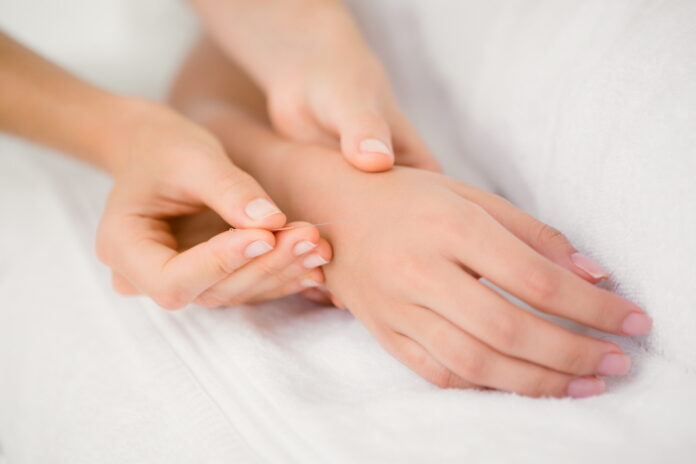By Manyong Park, Sungchul Kim, KMD
Saam acupuncture is one of the original therapeutic modalities representing traditional Korean medicine. It was originally described in a manuscript that is estimated to be published at some point between 1644 and 1742, in the middle of the Cho Sun dynasty, by a Korean Buddhist monk whose name is unknown. The principle of combining five shu points is based on the theory of Nan- jing. The treatment and diagnosis concepts in Saam acupuncture were mainly influenced by Dongeuibogam and Chimgoogyeong- heombang.
The basic characteristic of combining five shu points in Saam acupuncture is the selection of the tonification and sedation points along the self-meridian and other meridians based on creation and governor relationships. Saam acupuncture clinical studies have mainly focused on musculoskeletal pain and autonomic nervous system regulation. From a neurophysiological perspective, Saam acupuncture, which involves five shu points as the main treatment aspect, has the advantage of increasing parasympathetic nerve activation and adjusting the balance of the autonomic nervous system. Inserting a needle into the skin layer while considering the respiratory phase and stimulating the needle gently and lightly could maximize the effect of Saam acupuncture. The specific Saam acupuncture prescribed should be identified on the basis of the neurobiological perspective.
Saam acupuncture, which is one of the original therapeutic modalities representing traditional Korean medicine, is a unique treatment method that has a different origin than the modalities from China and Japan. The basic characteristic of combining five shu points in Saam acupuncture is the selection of the tonification and sedation points along the self-meridian and other meridians based on creation and governor relationships. In China, five element acupuncture, tonification, and sedation points along only the self-meridian are selected. Japanese meridian therapy added source point, connecting point, cleft point, alarm point, and transport point on the basis of Korea Saam acupuncture conception of the combined five shu points [1].
Saam acupuncture is based on the traditional concepts of yin-yang, five elements, ZangFu (viscera and bowels), qi, and meridians. Saam acupuncture treatment cannot be separated from these viewpoints. In particular, it involves the application of five shu points according to the creation and control cycles of the five-element theory. Therefore, the combination of acupoints in Saam is easier to understand from the perspective of traditional medicine.
The meridian is divided into three parts: the arm or foot, three yin and yang, and six ZangFu parts. A total of 24 deficiency and excess symptoms, with 24 coldness and fire symptoms, exist across the 12 meridians, but the diagnostic criteria related to these symptoms are too ambigu- ous for selecting a correct meridian. Except for the regular 48-treatment protocol, the treatment strategies are largely variable. Efforts were made to produce Saam treatments that are more effective by including other acupoints, with the main points firmly based on the regular pattern [2]. However, because the explanation regarding acupoint selection is very brief or elided, applying Saam acupuncture in the clinic is difficult.
Various Korean scholars have suggested different meth- ods for applying Saam acupuncture in the clinic. Lee [3] pro- posed a diagnostic system by comparing pulse examination, whereas Kim [4] proposed a symptom-based diagnosis.
Cho [5] established visceral pattern identification for provid- ing easy access to Saam acupuncture by analyzing Neijing (Internal Classic), Nan-jing (Classic of Difficult Issues), and Yixuerumen (Introduction to Medicine). Moreover, Kwon [6] studied constitutional acupuncture, and Kim [7] reviewed the mind-based aspect of Saam acupuncture.
However, a description of the mechanism of acupuncture to both clinicians and patients in mainstream medicine by using the contemporary concepts of neurobiology would be helpful for incorporating Saam acupuncture into mainstream medicine [8]. An important difference between traditional Korean medicine and the Western medical approach is the diagnostic process. In traditional Korean medicine, the diagnosis is made by using the principles of syndrome differentiation, which could be in accordance with the state of the ZangFu or qi or with the doctrine of the meridians [9]. This diagnostic process does not match the patterns in Western medicine.
In this paper, several neurobiological mechanisms of Saam acupuncture treatment are presented from the per-spective of the clinician. Saam acupuncture clinical trials are also discussed. Further, the historical background of Saam acupuncture and the basic principle of combining acupoints are briefly reviewed. (Hindawi Publishing Corporation, Evidence-Based Complementary and Alternative Medicine Volume 2015, Article ID 703439, 8 pages)
References
- O. Jung, D. H. Lee, and S. W. Ahn, “A research for tradition and identity of Saam acupuncture method,” Korean Journal of Acupuncture, vol. 29, no. 4, pp. 537–553, 2012.
- B. Ahn, K.-J. Jang, H.-M. Yoon et al., “A study of the Sa-Ahm Five Element acupuncture theory,” Journal of Acupuncture and Meridian Studies, vol. 2, no. 4, pp. 309–320, 2009.
- W. Lee, The Secret of Sa-Ahm’s Acupuncture Based on Yinyang and Five Elements, vol. 1, Institute for Studying Five Element Acupuncture, Busan, Republic of Korea, 1958.
- P. Kim, “Sa-Ahm’s five element acupuncture and its usages,” the Journals of the Korean Oriental Medical Society, pp. 122–123, 1972.
- H. Cho, The Systematic Res9earch of Saam Acupuncture, Seongbo, 2001.
- W. Kwon, “Constitutional acupuncture,” The International Journal of Acupuncture and Moxibustion, pp. 149–167, 1965.
- K. Kim, Revolutionary Review of Oriental Medicine, Sinlong- Bonche, Seoul, Republic of Korea, 2001.
- J. Cheng, “Neurobiological mechanisms of acupuncture for some common illnesses: a clinician’s perspective,” Journal of Acupuncture and Meridian Studies, vol. 7, no. 3, pp. 105–114, 2014.
- Cheng, Chinese Acupuncture and Moxibustion, Foreign Languages Press, Beijing, China, 1999




































